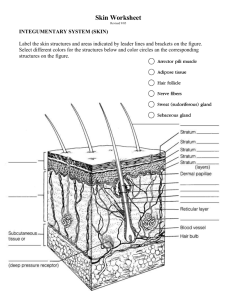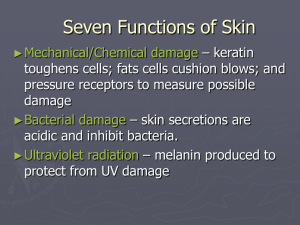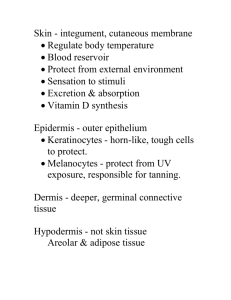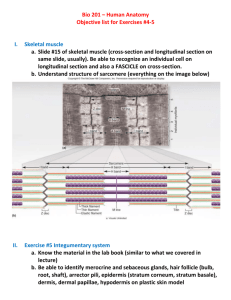Skin Functions of Skin
advertisement
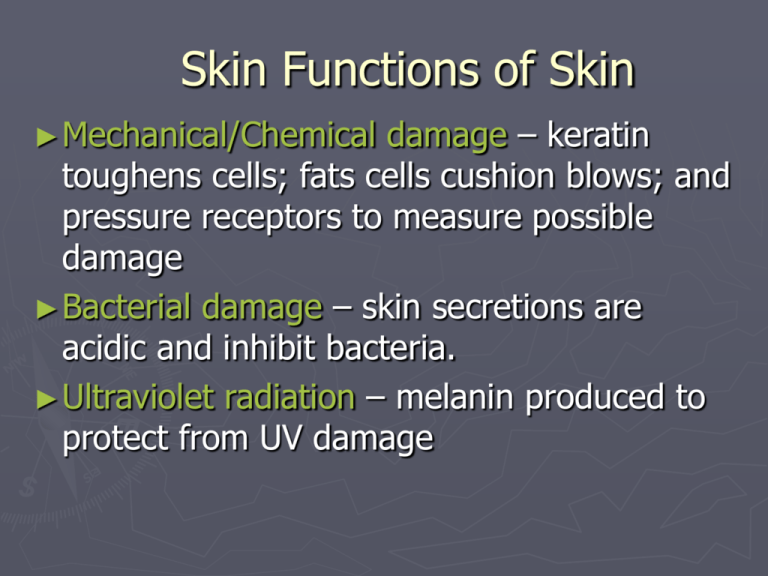
Skin Functions of Skin ► Mechanical/Chemical damage – keratin toughens cells; fats cells cushion blows; and pressure receptors to measure possible damage ► Bacterial damage – skin secretions are acidic and inhibit bacteria. ► Ultraviolet radiation – melanin produced to protect from UV damage Skin Functions ► Thermal control – regulates body temperature Heat loss: sweat to cool the skin Heat retention: prevents blood to rush into capillary beds ► Waterproofing – contains lipids to prevent drying out ► Excretion of waste – urea and uric acid secreted in sweat ► Makes vitamin D – modifies cholesterol molecules in skin and converts it to vitamin D Skin Structure ►Epidermis — outer layer Stratified squamous epithelium Often keratinized (hardened by keratin) ►Dermis Dense connective tissue ►Subcutaneous hypodermis tissue Skin Structure Summary of layers from deepest to most superficial: Stratum Stratum Stratum Stratum Stratum basale spinosum granulosum lucidum corneum Skin Structure ►Subcutaneous tissue (hypodermis) is deep to dermis Not part of the skin Anchors skin to underlying organs, bones and muscles Contains half of the body’s fat; acts as padding and insulation. Layers of the Epidermis ►Stratum basale Deepest layer of epidermis Cells actively undergoing cell division New cells are pushed upward to become the more superficial layers ►Stratum spinosum – intermediate layer ►Stratum granulosum – another layer Layers of the Epidermis ►Stratum lucidum Formed from dead cells of the deeper layers Occurs only in thick, hairless skin of the palms of hands and soles of feet ►Stratum corneum Outermost layer of epidermis Scale-like dead cells are filled with keratin which is a protective protein preventing water loss from skin Keratinization ► Cells migrate to the epidermis where eventually they fall off. ► As they move upward, keratin is added. ► The cells in the epidermis contain a lot of keratin which resists damage. ► Distinct layers of cells are called strata. A cell takes ~ 40 – 56 from creation to sloughing off Melanin ►Pigment (melanin) produced by melanocytes ►Melanocytes are mostly in the stratum basale ►Color is yellow to red to brown to black ►Amount of melanin produced depends upon genetics and exposure to sunlight Melanin continued…. ► ► ► Large amounts of melanin occur in some regions like freckles, moles, and nipples. Less melanin occurs in the lips, hands, and soles of the feet. All races have the same number of melanoctyes! The amount of melanin produced is determined by genetics. Albinism ►A single mutation can cause a deficiency or complete absence of melanin. ► Albinos have fair skin, white hairs, and unpigmented eyes Dermis ►Two layers Papillary layer (upper dermal region) ► Projections called dermal papillae Some contain capillary loops containing blood Some pain receptors and touch receptors Reticular layer (deepest skin layer) ► ► ► Blood vessels Sweat and oil glands Deep pressure receptors What causes Normal Skin Color ►Melanin Yellow, brown, or black pigments ►Carotene Orange-yellow pigment from some vegetables ►Hemoglobin Red coloring from blood cells in dermal capillaries Oxygen content determines the extent of red coloring Dermis ►Overall dermis structure Collagen and elastic fibers located throughout the dermis ► ► Collagen fibers give skin its toughness Elastic fibers give skin elasticity Dermal papillae – extend toward the epidermis and deliver nutrients, remove waste products (sweat = urea and uric acid) and aid in regulating body temperature. What causes Normal Skin Color ►Melanin Yellow, brown, or black pigments ►Carotene Orange-yellow pigment from some vegetables ►Hemoglobin Red coloring from blood cells in dermal capillaries Oxygen content determines the extent of red coloring
